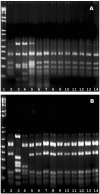Fluoroquinolone and other antimicrobial resistance in invasive pneumococci, Hong Kong, 1995-2001
- PMID: 15324545
- PMCID: PMC3323315
- DOI: 10.3201/eid1007.030612
Fluoroquinolone and other antimicrobial resistance in invasive pneumococci, Hong Kong, 1995-2001
Abstract
We determined the susceptibilities of 265 invasive isolates of pneumococci obtained during 1995 to 2001 in Hong Kong to 11 antimicrobial agents and their serotypes. Overall, 62.6% isolates were susceptible to penicillin, 20% were intermediately resistant, and 17.4% were resistant. The overall prevalence of levofloxacin resistance (MIC > or = 8 microg/mL) was 3.8% but increased to 15.2% among the penicillin-resistant isolates. All levofloxacin-resistant isolates were clonally related; had reduced susceptibility to penicillin, cefotaxime, and clarithromycin; and were derived from adults > or = 50 years of age. Of the penicillin-nonsusceptible pneumococci, 90% from children < or = 5 years of age and 54.8% from persons of all ages were of serotypes that are included in the 7-valent pneumococcal conjugate vaccine; 93.5% from children < or = 5 years of age and 93% from persons of all ages were of serotypes that are included in the 23-valent polysaccharide vaccine.
Figures


References
-
- Ho PL, Cheng VCC. Epidemiology and mechanisms of resistance. In: Ronald AR, Low DE, editors. Milestones in drug therapy: fluoroquinolone antibiotics. Berlin: Birkhauser; 2003. p. 49–72.
-
- National Committee for Clinical Laboratory Standards. Performance standards for antimicrobial susceptibility testing: eleventh informational supplement. 2001. M100-S11. Wayne (PA): The Committee; 2001.
Publication types
MeSH terms
Substances
LinkOut - more resources
Full Text Sources
Medical
Molecular Biology Databases
